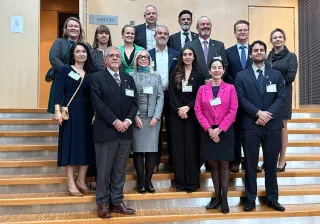VTT researchers were able to transmit light in wood-based fibre. Optical fibre made of cellulose is best suited for sensors that benefit from the biodegradability of the material. In the future, optical cellulose fibre may allow detecting changes in the moisture level of buildings.
"The core of the new optical fibre is made of cellulose, modified for the purpose using ionic solvents developed by VTT. Around the core, we made a cladding out of cellulose acetate. The R&D is still in its initial phases, so we do not yet know all the applications the new optical fibre could lend itself to", says Hannes Orelma Senior Scientist from VTT.
Light travels in the fibre, because the core is surrounded by cladding material with a lower index of refraction. Light is kept in the core since it is reflected back into the core from the interface of the core and the cladding.
"We have tested the suitability of the fibre for measuring moisture levels. Using a length of fibre of a few centimetres, we have already succeeded to increase the attenuation of light transmitted in the fibre many orders of magnitudes", says VTT's Research Scientist Ari Hokkanen.
Cellulose has properties making it suited for use in optical fibre sensors: The material used in cellulose fibres can in itself react with the substances being measured and absorb them, which is difficult for glass or plastic fibres. Cellulose is also easy to modify as regards, for instance, the index of refraction. Cellulose effectively absorbs and releases water, which can be measured by the change in the attenuation of light transmitted in the fibre. In addition, cellulose is biodegradable, and the fibre used for the sensor can be disposed of with biowaste.
Cellulose-based fibre opens up new opportunities for sensor applications, but it will not compete with glass-based optical fibres in telecommunications applications.
The development of the optical fibre began in VTT's iBex programme, which allows the researchers involved to implement fascinating solutions to global challenges. Currently, the R&D continues in the FinnCERES flagship programme in collaboration with VTT and Aalto University.
The research results were published in Cellulose Journal on 25 November, 2019: Orelma, H.; Hokkanen, A.; Leppänen, I.; Kammiovirta, K.; Kapulainen, M.; Harlin, A. (2019) Optical cellulose fiber made from regenerated cellulose and cellulose acetate for water sensor applications. Cellulose. DOI: 10.1007/s10570-019-02882-3.
Video: Light travels in the optical fibre made of cellulose, because the core is surrounded by cladding material with a lower index of refraction. Light is reflected back into the core from the interface of the core and the cladding.









